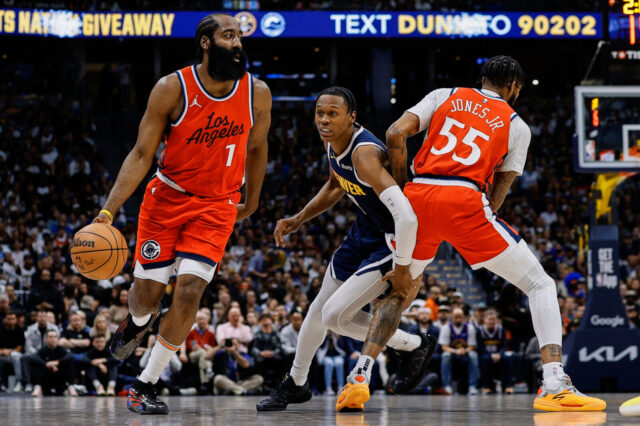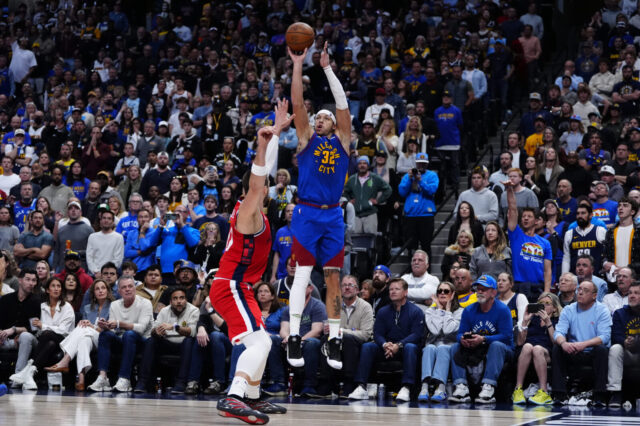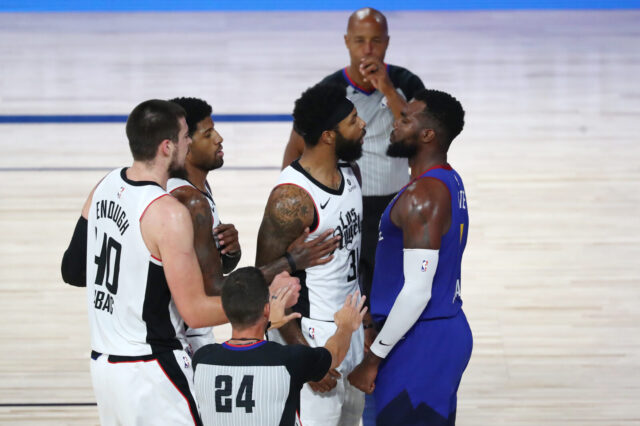Corey Brewer was one of my favorite Denver Nuggets, and it wasn’t because he owns a pet goat. Okay, that was part of it, but the main reason is for how easy he made scoring look.
If you remember the Nuggets with Corey Brewer, the first thing you probably think of is Brewer streaking down the court and hammering home a one-handed dunk, beating everyone down the floor. Brewer was a master of the leak out, constantly taking advantage of defenders to score in what seemed like the easiest way imaginable.
It seems like such a simple form of offense – just run faster than the defense and score before the defenders can establish position.
Former Grantland NBA writer Zach Lowe referred to the Nuggets as the “Rocky Mountain runners” at the peak of the Nuggets emphasis on transition. The 2012-13 Nuggets flew around the court, with Ty Lawson, Andre Iguodala, the afore-mentioned Brewer, Kenneth Faried, and Danilo Gallinari flourishing in Karl’s system. Nowadays the Michael Malone Nuggets are 21st in the league in transition points this season, with 11.4 percent of their possessions resulting in transition opportunities. As for George Karl, his new team, the Sacramento Kings, rank first in transition possessions per game, with a 18.1 percent mark this season.
As tempting as it may seem to go back to the days of flying down the court past the defense for dramatic finishes above the rim, the Nuggets ought to continue to focus on their half-court execution on offense rather than attempting to prioritize fastbreak offense for the following reasons.
1. Transition Relies Upon Mismatches
Corey Brewer was excellent in transition because he could literally outrun defenders. The player the Nuggets have that is the most obvious mismatch is Will Barton. Barton can outrun defenders consistently, and surprise, he does that multiple times per game! Barton is ninth in the league in total points scored in transition, with 151 points according to NBA.com stats.
A majority of those points are coming against second units, and is one of the reasons why Barton is strong contender for Sixth Man of the Year this season. It's great that Barton is able to successfully attack in transition, but oftentimes he finds himself slashing to the rim with three defenders crashing to the paint and no teammates nearby – not ideal.
The teams that do attack in transition have a common trait – guards that push the pace. The Nuggets don’t have that (outside of Barton), especially when Emmanuel Mudiay isn’t active. In 24 games, NBA.com has tracked 67 transition possessions for the rookie point guard. For the other Nuggets point guard, Jameer Nelson, NBA.com has tracked 33 transition possessions in 34 games this season. Michael Malone can talk about wanting to secure the defensive rebound and then look for transition opportunities, but with Nelson at the point, that is translating to one transition opportunity per game – that’s abysmal.
The players on the team should also favor a shift away from transition opportunities. The Warriors and Thunder are head and shoulders above the rest of the league in fastbreak points per game, but they also have the players for it. Russell Westbrook can dribble the length of the court in four seconds and Kevin Durant is 7-feet tall with a stride like a gazelle. The Warriors have lineups built around speed, with players like Steph Curry, Klay Thompson, Andre Iguodala, Shaun Livingston, Leandro Barbosa, Draymond Green and Harrison Barnes all able to get down the court in a hurry.
Outside of Barton and Kenneth Faried, the Nuggets have two young guards (Mudiay and Gary Harris) and a bunch of big forwards (Jokic, Nurkic, Lauvergne, Arthur and Hickson) that aren’t able to fly down the court in transition. As stated above, Jameer Nelson isn’t girding up his loins and racing down the court like John Wall or Darren Collison anytime soon. That lack of speed means there isn’t a lot of options for the Nuggets – teams need to adapt their schemes for their personnel. The 2015-16 Nuggets don’t have mismatches to take advantages of in transition, so they aren’t running.
2. The NBA Adapted
More and more, teams are abandoning offensive rebounds and deciding to get back on defense to prevent transition. Nearly 60 percent of field goal defensive rebounds this season have been secured by the defensive team with no offensive player contesting, according to rebounding statistics tracked by Nylon Calculus. In essence, teams are conceding defensive rebounds to minimize transition opportunities.
Brian Skinner created a stat, VOIR (Value of Improved Offensive Rebounding), to study how teams would improve by attempting to get more offensive rebounds. He found that an NBA team generally improves on offense by about 0.62 points per 100 possessions for each percentage point increase in its offensive rebound rate. Many teams in the league have decided that the points gained on offense do not outweigh the potential points given up in transition.
An example in an approach towards offensive rebounding and transition defense are the San Antonio Spurs. The Spurs have the No. 1 defense in the league, allowing the fewest points per game (89.7) while owning the best defensive rating (95.6). The Spurs allow 1.02 points per possession on transition plays, according to NBA.com stats, the second best mark in the league, trailing only the Chicago Bulls. Gregg Popovich tells his players “We don’t care if you get an offensive rebound in your entire life,” Lowe reports, and the Spurs routinely send all five players back on defense after a shot attempt.
“San Antonio set the model,” says Terry Stotts, the Blazers’ coach, in a column written by Zach Lowe. “Offensive rebounding has never been a priority for us.”
Doc Rivers, Terry Stotts, Steve Clifford, Stan Van Gundy, Rick Carlisle and Erik Spoelstra are all coaches that emphasize getting back on defense over offensive rebounding. Most of those coaches also appear on the list on longest-tenured head coaches in the league, and it’s safe to say they know what they’re doing when it comes to coaching basketball.
Lowe also brings up the shift towards smaller lineups where power forwards are playing farther away from the rim. It doesn’t make sense for a player like Kevin Love to run from the 3-point line into the paint for an offensive rebound when half of the time the other team secures the rebound and his momentum leaves him headed the wrong direction from the new possession. A player like Drummond can rack up offensive rebounds, but a large percentage of his shots are coming near the rim, and it’s easy for him to rebound his own missed shot. It’s much more difficult for Serge Ibaka to rebound his own miss if he’s shooting from 15-20 feet. Rebounds on jumpers also tend to result in an increase in transition opportunities, because guards are around more loose balls on misses and can take off down the court without having to wait for an outlet pass from a center or power forward.
This means that more teams have more players on the perimeter, with the defense getting more rebounds farther from the rim, but faced with more defenders moving back after a field goal attempt. Karl recognized that there was an advantage to be gained when teams sent two or three players towards the offensive glass, especially big, slow centers like Andrew Bynum or Hibbert. The league has adapted since then, and that advantage isn’t as available as it used to be.
3. Movement is the New Sexy
The Spurs have the third-most efficient offense in the league, averaging 110.4 points per 100 possessions. They are among the league leaders in passing, touches and distance. No team covers more distance on offense, while conversely, they are 27th in the league in distance covered on distance. They get the ball down to the free throw line by getting the ball to their forwards, moving after passing the ball, screening, cutting, and making the extra pass to find the best field goal opportunity.
Watch what their second unit does against the Minnesota Timberwolves.
It’s not like the Timberwolves didn’t have talented defenders out there – Ricky Rubio, Zach LaVine, Andrew Wiggins, Karl Anthony Towns and Gorgi Dieng are young players, but they are quick, long, and bouncy. Wiggins is a good defender and he ends up just hanging out in the key with no idea where Boris Diaw is for a good 10 seconds.
With all that ball movement, passing, and a focus on getting all five players touches on a possession, it is surprising that the Spurs are in the bottom-five of the league in pace. They don't shoot often in what NBA.com refers to as "very early" in the shot clock, with 8.8 percent of their field goal attempts coming in that time frame.
What the Spurs do best is get the ball quickly across halfcourt – they aren't walking the ball up the court. They initiate their offense quickly, often with 18 seconds remaining on the shot clock. They'll swing the ball to the other side of the court, run a dribble hand-off while running a shooter around a screen on the opposite side of the court, kick out to the perimeter, make an entry pass to a forward in the post, cut baseline, and generally create havoc for a defense for 18-24 seconds. It's really challenging to defend someone that moves for 24 seconds – trying to do that for five individuals in a coordinated manner is a monumental challenge.
SAS are exhibit A of a team that’s slow in “pace” but very fast in “half court pace.” That’s why I say their style isn’t THAT diff than 2013
— Adam Mares (@Adam_Mares) January 6, 2016
The Spurs SB Nation blog broke down how the Spurs are a slow-paced team that isn't a slow-paced team.
Calling the Spurs a low-paced team, evoking the Twin Towers era and contrasting them to the high-paced Warriors is as tempting as it would be reductive. Despite being almost in opposite ends of the pace spectrum, San Antonio and Golden State have much in common in terms of offensive identity.
This leads me to what I think is what the new “run and gun” should mean for the Nuggets. This combination of running and passing in half-court sets isn’t pace, by definition, so I refer to it as movement. A team that emphasizes movement will play a fast pace without necessarily playing up and down the court more than other teams in the league. The Brian Shaw Nuggets played at a high pace, because they play in Denver, and Denver teams have to run up and down the court, but it didn’t result in more points. If you watched Nuggets games during the Brian Shaw years, you can attest that the faster pace wasn’t successful.
One of my core ideas about basketball is that movement increases gravity. DDR and Wade are really good examples of this.
— Adam Mares (@Adam_Mares) January 8, 2016
DeMar DeRozan is an individual example of this, as pointed out by a smart basketball mind above. Despite being a sub-30 percent 3-point shooter, DeRozan averages 22.9 points per game, a career-best mark. Why are defenders even covering him outside of 18 feet? How is someone that bad at perimeter shooting and isn’t a center averaging over 20 points a game? DeRozan does it by being consistently in motion – only Jimmy Butler, C.J. McCollum and Damian Lillard cover more ground on offense than DeRozan. If a defender sags off him 25 feet from the basket, the Raptors will run a big into DeRozan’s man, or he’ll viciously cut towards the basket the second his defender turns his head away from him.
Watch what DeRozan does to the 76ers. Poor Nik Stauskas thinks, “Hey, I’ll jump up to prevent Patrick Patterson from setting this screen for DeRozan, and force him to drive into the paint.” Jahlil Okafor sees DeRozan drive, helps off Luis Scola with a “I got your back, Nik” attitude, without realizing that DeRozan has a vertical game.
That's what the threat of movement can do (as broken down here in more detail) – it can take a player that struggles to score from the perimeter and turn him into as efficient of a scorer as Lillard and or Paul. Movement is the new sexy.
I am not trying to argue that the Nuggets need to abandon transition points. When Malone says that he wants his team to "rebound and push" that is an entirely defensible position to take. However, it can't be the sole focus of a successful NBA team in the current NBA. The Nuggets can't become the Golden State Warriors – take Steph Curry's word for it, when asked about the small-ball lineup they are using to demolish the league this year.
"You can try to copy it, but you won't have the personnel. There isn't another Draymond Green, another Klay, another Andre. If you put your small-ball lineup next to ours, we like our chances. I call it the 'Uh-Oh Lineup.' I know when I get in with that lineup, something good's about to happen. I have so many different options. That lineup, in one word, is about versatility. Everybody can do everything."
What the Nuggets can do is utilize the talent they have on the roster. They can build a team that attacks in the pick and roll with Mudiay and Nurkić, gets Jokić the ball near the elbow, space efficient shooters like Gallinari and Wilson Chandler on the perimeter, and runs in transition on misses for vertical attacks from Faried, Barton and Harris. They can blankets opponents on defense like a wet rag for 24 seconds, rebound, block shots, and harass guards on the perimeter into turnovers.
The Nuggets have a good collection of young talent, veterans, and they can be flexible in the future with a solid combination of draft picks and cap space. If they are smart, they can put together a team that will be a contender for years to come.
Maybe the next step towards that successful future can be Will Barton buying an alpaca.


